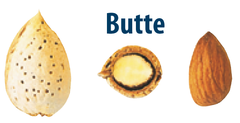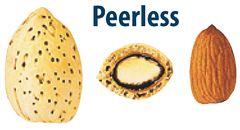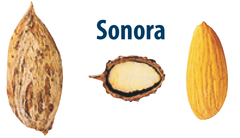5 Common California Almond Varieties
All California almonds aren't created equal. Each type is highly versatile and available in numerous varieties used to create quality products your taste buds will love. Each variety has its own characteristics that help determine the best uses for them.
Since Maisie Jane is a fourth generation almond grower, and we farm our own almonds, we have added knowledge on these different varieties and have perfected identifying which varieties work for each of our products.
Get the "hull" story about almond types and varieties, as well as their forms and characteristics. "Shell" we begin?
Almond Anatomy
 *Infographic Source: Almond Board of California
*Infographic Source: Almond Board of California
Mission Type
Mission type almonds have hard shells and their nuts are small, wide and often plump. The nut is darker than nonpareil and wrinkled which allows salt and flavoring adherence. Not generally blanched.
California Type
Blanchable varieties used primarily in manufacturing. Wide-range of shell hardness, nut shape, and skin color. Versatile.
Common Varieties of Almonds
 Used anywhere. An attractive appearance and strong almond profile is important. A thin outer shell and smooth nut permit easy, blemish-free processing. Medium flat nut with light color and smooth surface. Maisie Jane’s products focus on nonpareil.
Used anywhere. An attractive appearance and strong almond profile is important. A thin outer shell and smooth nut permit easy, blemish-free processing. Medium flat nut with light color and smooth surface. Maisie Jane’s products focus on nonpareil.
 Though technically a California type, it is popular enough to be classified separately. A soft shell variety used in blanching and roasting. Often substituted for nonpareils.
Though technically a California type, it is popular enough to be classified separately. A soft shell variety used in blanching and roasting. Often substituted for nonpareils.
 A Mission Type. Semi-hard shell with a light color and smooth surface. The nut is small, short, plump with a wrinkled surface.
A Mission Type. Semi-hard shell with a light color and smooth surface. The nut is small, short, plump with a wrinkled surface.
 A California Type. Hard shell with light color, smooth surface. The nut is medium size with a wide shape and a fairly wrinkled surface.
A California Type. Hard shell with light color, smooth surface. The nut is medium size with a wide shape and a fairly wrinkled surface.
 A California type with a paper thin shell with dark brown color and rough surface. Nut is large, long, narrow with light color and smooth surface.
A California type with a paper thin shell with dark brown color and rough surface. Nut is large, long, narrow with light color and smooth surface.
Unlike some processors, we hand select the best variety of almonds for every single product we make, assuring the best quality and best-tasting almond products across the board.
Knowing the different types and varieties of almonds can help add flavor to your favorite recipe or serve up a healthy snack. Remember, an almond is not just an almond.

